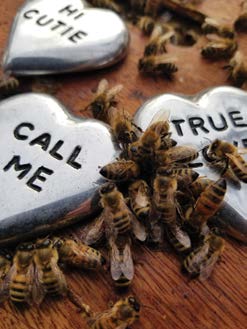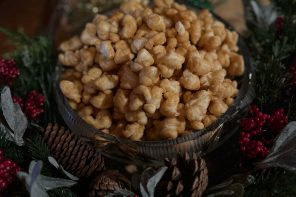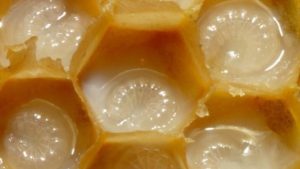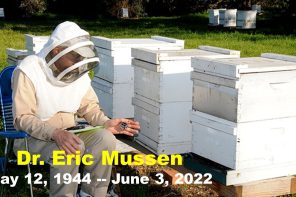Bee Mine
By: Becky Masterman and Bridget Mendel
Did bees invent Valentine’s Day? No, they did not. The holiday was in fact established by Pope Gelasius in AD 495 in honor of a Christian saint by the name of Valentine. But that doesn’t mean you can’t utilize the holiday to promote pollinator-friendly actions at every turn, unprompted! Below are eight activities that will let your sweetheart know, “I love you, but I love pollinators more.”
1. Pivot the conversation from romantic sentiments to cold hard facts. The fact is, Saint Valentine was the patron saint of beekeepers.
2. Use the holiday to promote pollinator diversity! Stick a note in that box of chocolates, letting your new lover know that not all pollinators are bees. In fact, a small, humble fly called a midge is responsible for pollinating chocolate.
3. When presenting a single red rose to your crush, make sure to clarify that bees need flowers way more than they do. Keep their attention by explaining that not all roses are equally attractive to bees, and that bees prefer open, wild roses over highly cultivated ones that do not provide nectar and pollen. Furthermore, stem-nesting bees like to make homes in rose stems. In fact, you may want to take back that rose as you could just as well use it to create a solitary bee house.
4. Surprise your spouse when instead of your usual Hallmark card that says “Bee Mine” on the front, you enclose a very long, handwritten explanation about how and why honey bee hearts function. Explain that bees have an open circulatory system that moves hemolymph (insect blood) via a dorsal tube. Their heart, or dorsal aorta, is in their abdomen and moves hemolymph from their abdominal cavity, through the thorax to their heads while serving their immune system, transporting hormones and nutrients while facilitating thermoregulation. Honey bees are able to forage at relatively high and low temperatures due to the temperature regulation provided by their circulatory system.
5. When your special someone surprises you with a candle-lit dinner, use the opportunity to talk about pesticide contamination in beeswax. While it may ruin the mood, your partner needs to know that there are probably dozens of different chemical contaminants in those candles. The wax cappings from honey supers contain fewer pesticides than wax from the brood nest. Also, researchers are working on a process to remove most of the pesticides from beeswax (Calatayud-Vernich et al. 2019).
6. Comment on the fleeting nature of love by making your Valentine’s Day cards on flower seed paper. Your love may fade away, but your valentine card can be buried in the earth and sprout seeds as early as May or June, providing food for bees. To stay on message, check out the ‘bee a little punny Valentine’s Day card’ blog post referenced below for a tutorial on making the perfect card for the occasion.
7. While dropping off a box of bees on somebody’s doorstep is not always interpreted as merely whimsical, in some cases, surprise bees are appreciated. Show your love to a total stranger by giving them the gift of honey bees! With apicultural programs in Honduras, Nicaragua, Peru and Guatemala, Heifer International promotes and supports sustainable community development. Supporting beekeeping via this non-profit will help small scale farmers add additional revenue streams through sales of honey and wax.
8. If you don’t have a Valentine this year, you may consider baking. It’s self love in the best way. And don’t forget, even if it’s all about you, it’s also about the bees. Promote local beekeepers by adding honey to everything you bake, or don’t bake (Sioux Honey has five no-bake honey goodie recipes that will save precious time that you probably need to spend on your bees).
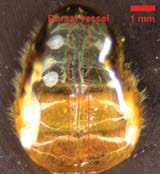
A dissection of a honey bee showing the position of the dorsal vessel (heart) in the abdomen. While hemolymph flows freely in the body cavity, it is circulated from the abdomen to the head via the dorsal vessel (O’Neal and Anderson, 2016).
Photo credit: Scott O’Neal
References and Resources
More about St. Valentine
https://www.history.com/news/6-surprising-facts-about-st-valentine
Learn about bee hearts and their circulatory systems
Hillyer JF, Pass G. The Insect Circulatory System: Structure, Function, and Evolution. Annu Rev Entomol. 2020 Jan 7;65:121-143. doi:10.1146/annurev-ento-011019-025003. Epub 2019 Oct 4. PMID: 31585504.
Michel J. Honey bee hearts. Proc (Bayl Univ Med C e n t ) . 2018 Dec 20; 32 (1) : 154 – 155. doi:10.1080/08998280.2018.1509578. PMID: 30956616; PMCID: PMC6442803.
Heinrich, B., & Esch, H. (1994). Thermoregulation in Bees. American Scientist, 82(2), 164–170. http://www.jstor.org/stable/29775151
Honey bee heart photo
O’Neal ST, Anderson TD. Dissection and Observation of Honey Bee Dorsal Vessel for Studies of Cardiac Function. J Vis Exp. 2016 Dec 12;(118):55029. doi:10.3791/55029. PMID: 28060305; PMCID: PMC5226400.
Where to buy bees for others
https://www.heifer.org/blog/st-valentine-patron-saint-of-beekeepers.html
Make Punny Beekeeper Valentines
https://breakingaverageblog.com/2021/02/07/bee-a-little-punny-valentines-day-card/
Pesticide removal from beeswax
Calatayud-Vernich, P., VanEngelsdorp, D., & Pic , Y. (2019). Beeswax cleaning by solvent extraction of pesticides. MethodsX, 6, 980–985. https://doi.org/10.1016/j.mex.2019.04.022
Valentine treats made with honey
https://siouxhoney.com/5-valentinesday-treats-made-with-honey/
Acknowledgement
The authors would like to thank Dr. Marla Spivak for helpful edits and suggestions and Scott O’Neal for granting permission to use his dorsal vessel photo.
Authors
Becky Masterman led the UMN Bee Squad from 2013-2019. Bridget Mendel joined the Bee Squad in 2013 and has led the program since 2020. Photos of Becky (left) and Bridget (right) looking for their respective hives. If you would like to contact the authors with your Valentine’s Day success stories or other thoughts, please send an email to mindingyourbeesandcues@gmail.com

Becky Masterman

Bridget Mendel






